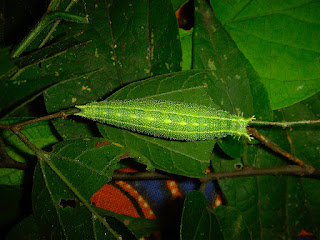And shortly came their near cousin, the Variegated Fritillary, and its caterpillar, just the same as the Gulf, but with a white line running its length.
Next we planted a sassafras tree, to see if we could attract a Spicebush Swallowtail, and sure enough, as soon as the tree was big enough to have a few leaves, we found one of them folded over to hide the snake-headed caterpillar.
And it was easy to plant a bit of parsley or fennel, and we immediately had Black Swallowtails. The early instar caterpillars mimic bird droppings, so nothing will be interested in eating them, and then their later instars pretend to be Monarch caterpillars, which are known to be poisonous from eating milkweed leaves.
We already had a sugarberry tree in the yard, so we already had Hackberry Butterflies, since that was the tree they laid their eggs on. The adult males post themselves around the yard, chasing females, and chasing off rival males.
Their somewhat slug-like caterpillars.
And we also already had winged elm trees in our yard, so we only had to look carefully to see we had Question Marks, with their odd way of stacking their eggs three or four high.
We planted a cherry tree, and birds spread seeds of it all over the yard, so we now have several, and almost any day you can see the Red-spotted Purples laying their eggs carefully at the tips of the leaves, and their caterpillars are easy to find.
Though they are less common than the Red-spotted Purples, we also get Eastern Tiger Swallowtails laying their eggs on the cherry leaves. Like many swallowtail species, their caterpillars start out by mimicking bird droppings, and later instars then become snake mimics.
We planted spring cress, and that lured tiny Falcate Orangetips into our yard to raise their beautiful caterpillars.
We planted senna to attract the various species of sulphurs, including the Cloudless Sulphur.
One day we were at the Arkansas Folk Center in the middle of the Ozarks and we bought a little pot of rue, which is a food plant for the Giant Swallowtail. We didn't have any appropriate plants in our area, so we brought it home and planted it. We only get Giant Swallowtails in our yard once or twice a year (perhaps because there are no plants of the right kind), and almost instantly a Giant came by and laid two eggs on our rue. The caterpillars gorged on the plant, growing bigger and bigger, and we realized they were going to eat all the rue before they were big enough to make their chrysalises. So we did what any besotted insectophile would do: We made the 300-mile round trip to the Folk Center for another pot of rue. Now to be a little safer, we have planted a wafer ash tree (another Giant Swallowtail food plant, this one much larger) and are waiting to see if it will work.
I haven't even mentioned yet the most obvious one of all: Naturally among our first plantings were milkweed plants, mainly common milkweed and butterfly weed. On their northern flights the Monarchs would cover the plants with eggs, and the caterpillars would eat the plants right to the ground. The plants would then grow right back up, to be ready for any later Monarchs that were still laying eggs. Now, sadly, there are many fewer Monarchs coming through, and the milkweeds sometimes go untouched.
Well, that's thirteen. There are still many more. Once I started doing this I was surprised myself at how many had slowly accumulated over the years. I didn't get around to mentioning Sleepy Orange (on senna), Red Admiral (on nettle), Goatweed Leafwing (on Goatweed), Silver-spotted Skipper (on indigo bush), Horace's Duskywing (on oak), Silvery Checkerspot (on black-eyed susans).
I don't believe we have ever planted a plant for the purpose of attracting a specific moth (well, I guess we planted a catalpa tree to attract catalpa hornworms), but if you have a variety of plants, you will get many moth caterpillars anyway. Moths in general can be rather drab (or, as my wife prefers, their beauty is more subtle), but on the other hand, their caterpillars go far beyond the usually rather staid butterfly caterpillars for spectacular patterns and shapes and behaviors and overall screwiness with tufts of hairs going in every direction and weird tendrils sticking up or hanging down. We are having such a banner year for caterpillars this year that I might make my next blog a moth-caterpillar-in-our-garden blog



























No comments:
Post a Comment